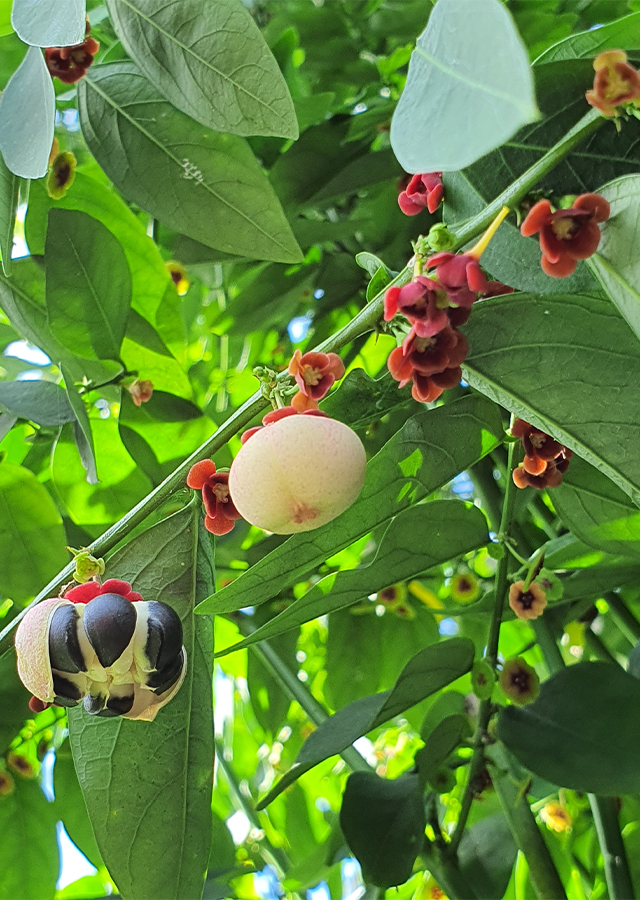Sweet leaf
Breynia androgyna (L.) Chakrab. & N.P.Balakr.
Phyllanthaceae
Location in our garden
Principal



Synonym
Clutia androgyna L.
Phyllanthus acidissimus Noronha
Sauropus androgynus (L.) Merr.
Habitus
Shrubs. A plant that can grow up to 3 m tall.
Part Used
Leaves
Roots
Growing Requirements
Full Sunshine
Need Shade
Drought Resistant
Habitat
Forest
Shrublands
Overview
The exact origin of the sweet-leaf is unknown, but it occurs from India and Sri Lanka to Southern China and Indo-China and throughout South-East Asia, mainly in cultivation, but also wild. The plant is widely cultivated in several countries in East and South-East Asia as a medicinal plant and vegetable.
Vernacular Names
Cekur manis (Malaysia), Hvaan baanz (Laos), Phakwan-ban (Thailand), Binahian (Philippines), Yo-ma-hin-yo (Myanmar), Dom nghob (Cambodian).
Agroecology
A plant of the tropics, where it is well adapted to lowland conditions but can also be cultivated at elevations up to 4,000 m, grows best in areas where annual daytime temperatures are within the range 26-35 °C but can tolerate 5-38 °C. It prefers a mean annual rainfall in the range 900-1,200 mm, but tolerates 600-4,000 mm. Succeeds in full sun and semi-shade. Prefers a pH in the range 6-7, tolerating 5.5-7.5.
Morphology
- Stem - long and upright.
- Leaves - biseriate, alternate, oblong to orbicular, 2-7.5 cm × 1-3 cm, entire, glaucous, above dark green, often with vague greyish spots, beneath the light green.
- Flowers - small and red.
- Fruits - a globose to the faintly 6-angular capsule, about 1.5 cm in diameter, white or purplish, dehiscing with 3 valves.
- Seeds - black, when fully mature, they split open to reveal up to 6 black angular seeds.
Cultivation
This plant can be propagated through leaf cuttings, stem cuttings, and seeds sowing.
Chemical Constituents
Alkaloids, steroids/triterpenoids, saponins, tannins, polyphenol, glycoside, flavonoids, papaverine, sterols, catechol, cardiac glycosides, acidic compounds.
Traditional Medicinal Uses
- The leaves are used as a medicine for coughs and to soothe the lungs, as a tonic, and as a febrifugal to relieve internal fever.
- Previous studies have reported the prospective of this plant as an antioxidant, antimicrobial, wound healing, anti-inflammatory, antidiabetic, and antiobesity agent as well as it's potential to increase breast milk production.
- A decoction of the roots is used against fever and urinary problems, and to relieve congestion.
- The leaves of this plant have been used to treat certain diseases, for weight loss, and as vegetable dishes.
- These are the health benefits of sweet leat for pregnancy and breastfeeding.
- The leaf juice is used to treat cholecystitis, diarrhea, and other forms of fever, rhinosis.
- Decoction of the leaves and roots is a remedy for epistaxis and oriental sores.
- Another application of the leaves is for oral thrush in infants. Paste of the leaves is applied over nasal ulcers and yaws, erythema, and measles.
Part Used
Reference Sources
- Fern, Ken. (2019). Useful Tropical Plants. Sauropus androgynus. http://tropical.theferns.info/viewtropical.php?id=Sauropus+androgynus. 22-01-2021.
- Hindawi. (2015). Sauropus androgynus (L.) Merr. Induced Bronchiolitis Obliterans: From Botanical Studies to Toxicology. https://www.hindawi.com/journals/ecam/2015/714158/. 22-01-2021.
- PROSEA. (2016) Sauropus androgynus (PROSEA). https://uses.plantnet-project.org/en/Sauropus_androgynus_(PROSEA). 22-01-2021.
- Pfaf. (No date). Sauropus androgynus - (L.) Merr. https://pfaf.org/user/Plant.aspx?LatinName=Sauropus+androgynus. 22-01-2021.
- Tamanna Arif and Raviraja Shetty G. (2020) Therapeutic potential and traditional uses of Sauropus androgynous: A review. https://www.phytojournal.com/archives/2020/vol9issue3/PartAI/9-3-330-854.pdf. 22-01-2021.

